
24 minute read
OPC UA - from automation pyramid to information network
THE FIELD LEVEL COMMUNICATIONS INITIATIVE has reached a major milestone. OPC UA FX extends OPC UA to the field including APL, TSN and 5G technologies
Introduction
A little over two years after its launch, the Field Level Communications (FLC) Initiative of the OPC Foundation has completed the first release candidate (RC1) of the OPC UA FX (Field eXchange) specifications supporting the horizontal communication between shop floor systems, including the exchange of real-time and safety-critical data between controllers (e.g. PLC, DCS) in a vendor-independent way.
This marks an important milestone to further develop OPC UA as a uniform and manufacturer-independent industry interoperability solution that fully scales from field to cloud, including communication and information exchange at the control and field level. For this, OPC UA is taking advantage of enabling communication technologies, such as Ethernet-APL (Advanced Physical Layer) Ethernet TSN (Time-Sensitive Networking, as well as 5G mobile networks.
FLC Initiative: goals/achievements
In November 2018 the FLC initiative was founded under the umbrella of the OPC Foundation. A total of 27 companies, including the largest automation manufacturers in the world, have joined the initiative's Steering Committee and support it financially as well as with man-power and technical know-how.
The common goal is to expand the scope of OPC UA to the field level and to establish OPC UA as a uniform and consistent communication standard in factory and process automation. In the technical working groups, which are open to all members of the OPC Foundation, a total of over 300 experts from more than 60 companies are currently working together in order to develop appropriate concepts and specifications.
Work on the first version of the specification has made good progress - despite Covid-19 and the associated restrictions. The basic concepts for the use case Controller-toController (C2C) have been developed and have been incorporated into a first set of specifications. The first release candidate (so-called RC1) has been completed and is now used to implement prototypes and to execute interoperability testing in order to validate the specifications. At the same time, test specifications are being generated which will later be converted into corresponding test cases for the OPC UA Compliance Test Tool (CTT).
In a second version of the specification, the already developed concepts will be extended for the use cases Controller-to-Device (C2D) and Device-to-Device (D2D), which will then enable that OPC UA can be used as a uniform and consistent communication solution for vertical and horizontal integration, including field, edge and cloud.
This opens up completely new possibilities, especially with regard to the various Industry 4.0 and IIoT use cases and application scenarios which target to make the production more efficient and more flexible.
OPC UA solution for the field level
OPC UA Framework
The field extensions specified by the FLC Initiative are based on the OPC UA Framework (IEC 62541), which enables a secure and reliable, manufacturer and platformindependent information exchange.
Controllers and field devices support both, the connection-oriented client/server communication model and the publish/ subscribe extensions, which are indispensable for communication at the field level due to the corresponding requirements for flexibility, efficiency and determinism. The security mechanisms specified in OPC UA are also used, which, among other things, support

authentication, signing and encryption of the data to be transported and can be used for both client / server and publish / subscribe communication relationships.
OPC UA FX - Extensions for Field Exchange
The first release candidate of the FLC Initiative consists of four specification parts (OPC UA Parts 80-83) and focuses on C2C communication (Controller-to-Controller) for the exchange of process and configuration data by means of peer-to peer-connections and a basic diagnosis. These parts are labelled with OPC UA FX (Field eXchange):
Part 80 (OPC UA FX 10000-80) includes an introduction and provides an overview of the basic concepts for expanding OPC UA for communication with and at the field level.
Part 81 (OPC UA FX 10000-81) specifies the basic information model for controllers and field devices (automation components) and the communication concepts to meet the various use cases and requirements of factory and process automation.
Part 82 (OPC UA FX 10000-82) describes network services such as topology detection and time synchronization.
Part 83 (OPC UA FX 10000-83) describes the data structures for the exchange of information required for offline engineering using descriptors and descriptor packages.
In addition, a 40-page technical paper was published that explains the overall vision and the technical approach. OPC UA Safety – fail-safe communication based on Profisafe
Work on the safety solution for OPC UA (OPC UA Safety) is also very advanced. A first OPC UA Safety specification based on client-server mechanisms was developed by a Joint Working Group with Profibus & Profinet International (PI) and was already published in November 2019 (Part 15, OPC 10000-15).
A revision of the OPC UA Safety specification will be available shortly, which describes the extensions for OPC UA Pub/Sub and the parameterization of safety devices including C2D (controller-to-device). OPC UA Safety supports a maximum user data length of 1500 bytes, the creation of any network topology (star, line, grid, ...), hierarchical safety IDs for simplified management of series machines and dynamic connection setup with changing partners, such as modular machines, Autonomous Guided Vehicles (AGVs), Autonomous Moving Robots (AMRs) and tool changers, etc.
OPC UA Motion based on Sercos and CIP Motion
Progress can also be reported with regard to OPC UA Motion. A working group has started in Mid 2020 to develop an OPC UA-based motion solution comprising of motion control functions for various types of motion devices such as controllers, standard drives, frequency converters and servo drives.
The FLC Steering Committee has agreed to base the work on the CIP Motion and Sercos specifications and to adapt them to the OPC UA information modeling and system architecture, taking into account the relevant Industry 4.0 and IIoT use cases. The fact that, as with safety, existing concepts and specifications are being used, the specification work can be significantly accelerated.
OPC UA with APL, TSN and 5G
OPC UA is much more than a protocol. Instead, it is an industrial framework which is fundamentally transport-agnostic and therefore can be easily adapted to different transport layers depending on the application-specific requirements and use cases.
By making use of a universal Quality-ofService (QoS) modelling concept, which includes real-time communication capabilities with guaranteed bandwidth and low latencies, information and services can be easily mapped to different underlying transport protocols and physical media with their particular QoS mechanisms.
For OPC UA FX two communication profiles are defined. One is mapping the OPC UA protocol (UADP) to UDP/IP. The other one is directly mapping UADP to Layer 2 Ethernet resp. Ethernet TSN. The latter option is being used to reduce the protocol overhead and to increase the protocol efficiency for demanding automation applications, such as Motion Control or High-speed I/Os.
Key technologies for bringing OPC UA to the
field level are Ethernet-APL (Advanced Physical Layer) and Ethernet Time-Sensitive Networking (TSN). But OPC UA applications will not be bound to wired Ethernet technologies only. Wireless communication standards, such as 5G or Wi-Fi 6/7 support similar QoS guarantees and are therefore also supported in the future.
The combination with APL
Ethernet-APL describes a physical layer for Ethernet that was specially developed for the requirements of the process industry. Ethernet-APL enables data transmission at high speeds over long distances, the supply of energy and data via a common, twisted 2-wire cable and protective measures for safe use in hazardous areas.
This makes Ethernet-APL the enabling technology for the use of OPC UA and other Ethernet-based protocols in the process industry. Due to the special importance of this technology, the OPC Foundation joined the Advanced Physical Layer (APL) project group in June 2020 to develop and promote APL together with other non-profit organizations and various industrial partners.
The combination with TSN

OPC UA Framework with extensions for Field eXchange (FX) .
By using Ethernet TSN, deterministic data transmission via OPC UA is facilitated, which is particularly indispensable for demanding automation applications. In addition, TSN allows different applications and protocols to be operated using a common network infrastructure based on open standards. This enables convergent industrial automation networks to be implemented in which various IT and OT protocols can coexist.
A working group of the FLC Initiative is currently identifying which TSN sub-standards are mandatory for OPC UA-based end devices and infrastructure components in order to meet the specified requirements for performance, flexibility and ease-of-use.
The OPC Foundation has given a clear commitment to the TSN-IA (Industrial Automation) profile, which is being developed by the IEC / IEEE 60802 working group. For this reason, the OPC Foundation has entered into liaisons with the standardization bodies
IEC SC65C and IEEE 802.1.
The combination with 5G Data exchange via OPC UA is not limited to wired or wireless Ethernet communication. Support for the 5G mobile communications standard is also on the OPC Foundation's roadmap. For this, the OPC Foundation has been working on concepts to include 5G in its Quality of Service (QoS) modelling concept to enable the seamless integration of 5G into the existing OPC UA architecture. Furthermore, a cooperation with the 5G Alliance for Connected Industries and Automation (5G-ACIA) has recently been established, in order to identify and leverage the synergies of combining OPC UA with 5G with the goal to support Industry 4.0 & IIoT applications with a reliable and at the same time flexible communication solution.
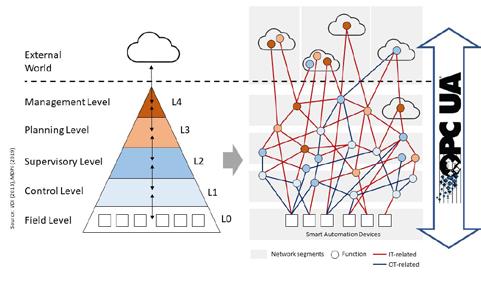
Summary and conclusion
The OPC UA (IEC 62541) framework with the extensions for field exchange (OPC UA FX) specified by the FLC Initiative, in combination with underlying communication technologies such as APL, TSN and 5G, offers a complete, open, standardized and interoperable solution that not only fulfills the requirements of industrial communication, but at the same time enables consistency and semantic interoperability from the field level to the cloud and vice versa.
With this approach - and by adopting additional device companion specifications that are developed by numerous organizations all over the world - information is made available with a standardized semantics directly at the data source, if possible: A flow meter for example offers directly standardized "OPC UA flow measuring data" as soon as the APL cable is plugged in.
And analogously, servo drives directly process standardized "OPC UA drive setpoints” and provide standardized “OPC UA actual drive values” as soon as they are integrated into a machine network with Ethernet TSN.
Peter Lutz, Director FLC, OPC Foundation.


Industrial connectors and cables are in a period of rapid innovation. Along with the emergence of Single Pair Ethernet, this new environment is creating higher demands on products is producing solutions that are offering higher data rates, increased levels of protection and options for miniaturization.
THE LATEST GENERATION OF INDUSTRIAL Ethernet connectors and cabling are being driven by a series of key technical trends and more stringent requirements aining to boost industrial network performance. Compared to IT applications, industrial applications place higher demands on new products.
“It is not only the signaling performance that is constantly being driven upwards by higher data rates, but properties such as increased protection class, miniaturization and expanded mechanical requirements also play a decisive role,” Michael Kasper, Director of Accessories Products at Siemens AG told IEB.
“Of course, the convenient handling of the connector must not suffer from these technical requirements. Particularly in the Operational Technology (OT) environment, in which cables often have to be assembled on site, the user demands a simple, error-avoiding design of the connector. In short, Cat6A, small size and assembly in the field must not be mutually exclusive,” he added.
Technology innovations
Kasper said that innovations are being driven by the idea that industrial data communication is not a topic for specialists, but a topic that can be mastered by everyone. By using new materials and connection technologies, plugs can be easily installed in the field without additional special tools, even by untrained personnel. Colored markings in the connector help to avoid incorrect contact. In addition, clear installation videos, which can be easily accessed via a QR code on the packaging, help ensure that the installation is suitable for industrial use.
A growing set of application requirements that are also influencing new product development and connector/cabling solutions.
One area is increasing data rates, or applications in which fewer wires, that are to be used for Ethernet communication and require high-performance connectors that must be fault-tolerant and easy to use at the same time.
“The user expects that these products can be installed by anyone without having to check them for correct quality using complex testing procedures before commissioning, as in the laboratory, Kasper said. “The construction of communication networks, also in industry, must be as easy as it is for the commercial target group in home use. No specialist knowledge or special equipment may be required to set up communication networks.”
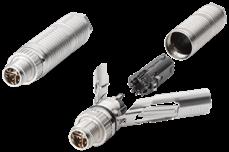
Industrial connectors and cables are responding to a growing set of application requirements.
SOURCE: SIEMENS
Single Solutions
“The big trend/need in industrial networking is the drive toward finding and using a single solution vs. having to rely on multiple components and parts,” Ruud van den Brink, product manager for industrial communications at TE Connectivity told IEB.
“The industrial internet of things (IIoT) is about connecting and processing data in real time from machines, factories, enterprises and supply chains around the world. It's a datadriven world where decisions are faster, more rational and more efficient. And it’s one where factories are smarter, with machines talking to the entire world, learning and continuously optimizing each other's performance. These smart factories require smart machines,” he said.
The unique technical benefits that these innovations provide are focused on ways to make communication networks more effective. Most automation networks today are built up out of different communication protocols from serial or bus communications, to Ethernet. Ideally, the whole network would be built up with Ethernet-based connectivity using Ethernet-based connector types so you don't have any conversions between protocols or limits in information flow.
“In newer networks, Ethernet is taking over at the expense of serial communication and bus communication,” van den Brink added. “If we look at all of these trends, there are a couple solutions that we support. The first one—RJ45—is very well known; a connector that comes out of the office space and has made its way into industrial networks. Performance-wise, it’s a typical office connector, which causes various problems when used in an industrial environment. Other solutions stand up better to the demands of the industrial environment, including Mini I/O—a very small, ruggedized connector, and the M8 and M12 products, which have addressed the industrial requirements for quite some time.”
But for a true glimpse into the future, many industrial companies are considering Single Pair Ethernet (SPE). SPE addresses an application space that’s been more or less out of reach for the other three connectivity methods, finally getting Ethernet into the industrial network.
Engineering challenges
At TE Connectivity, IIoT work is all about getting data from the network into a database for further processing to optimize an IIoT-based network. Their goal is to interconnect all of the different sources of data so all available data makes it into the database for further analysis.
“We know engineers are facing a number of challenges in their industrial environments,” van den Brink said. “Networks have grown more automated and complex while also becoming decentralized so more local connectivity and connectivity on the factory floor is required. This demands solutions that are not only waterproof and dustproof, but also able to withstand intense vibration, shock and heat. Plus, the connectors are growing smaller and more dense. As a result, reliability is more important than ever. Customers need a product that’s rugged, yet easy to install and repair, with fast data transmission speeds (10 – 100 Mb per second).”
These challenges are compounded by the different components, connectors, systems and parts used in many networks today. van den Brink said TE is addressing all of those fields and as such, has a total solution available for every company that plays a role in implementing industrial IIoT networks.
New Industrial Ethernet connector facilitates access to the IIoT. Faster assembly saves users valuable time.
The RJ Industrial MultiFeature is a significantly improved version of the classic RJ45 in terms of handling. Thanks to a robust metal housing and integrated knives that automatically shorten the strands to the correct length during assembly, handling is greatly simplified. Shorter assembly time saves valuable time in system installation. Consequently, the most frequently deployed data interface has been further optimized for use in industrial environments.
Targeting designers of miniaturized devices, HARTING will be showing all the innovations and portfolio extensions revolving around the space-saving ix Industrial® Ethernet interface. The interface is 70% smaller in size, offering Gbit Ethernet with a more compact footprint while increasing stability at the same time. Standardized in IEC 61076-3-124, ix Industrial® represents the future standard for 8-wire Gbit Ethernet in automation scenarios. In traditional RJ 45 solutions for industrial networks, the time for confection is 50% for preparation of the cable and 50% for connecting. With the new RJ Industrial® Multifeature, users get a robust and reliable connector with integrated cutting tools for fast and easy assembly. A time saving of about 25% in the assembly is possible.
This completely dispenses with this timeconsuming step and the entire assembly is more than 25% quicker. There is no longer a need to shorten the individual wires 8 times using the wire cutter and the quality of the connection process is also improved. The wires are always safely shortened in the same place in each connector and this also ensures that the HF performance of all assemblies is identical.
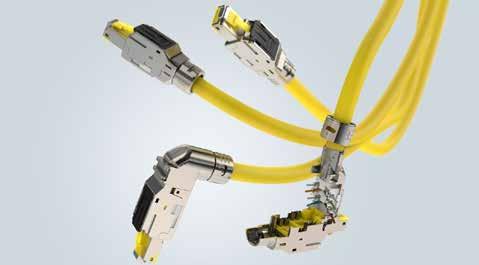
The RJ Industrial® MultiFeature is a significantly enhanced version of the classic RJ45.
HARTING
Visit Website
Industrial Ethernet cable solutions
Helukabel offerings include cables and field harness connectors, and Plug & Play patch cables.
The RJ45 and M12 d- or x-coded overmolded patch cables product range from Helukabel has been enlarged with ix Industrial acc. IEC 61076-3-124 standard. ix Industrial is key to the miniaturization of devices such as cameras or computers. The secret lies on the socket side which is on the circuit board. Compared to a classic RJ45 socket, a socket with the new mating face offers up to 70% space saving compared to other alternatives.
With this new mating interface, three different codings allow for efficient Ethernet and bus transmission or signal cable interconnection.
A-code for Ethernet/Profinet transmission
B-code for signal or bus transmission
C-code for Ethernet
Thanks to the double locking of the ix Industrial connector, there is an enhanced protection from vibrations compared to conventional RJ45 connectors. Vibration which has until now been a problem can now be a thing of the past.
Furthermore, the 10-pin assignment option means that the connector has a promising future in terms of hybrid cables. For example, 2- or 4-pair Ethernet cables can be expanded with two power supply wires and connected with only one connector.
If a customer cannot use pre-assembled cables due to issues with spacing, there is, of course, the option to purchase cables and plugs / sockets from Helukabel as individual parts and to install these in the field to create effective solutions.
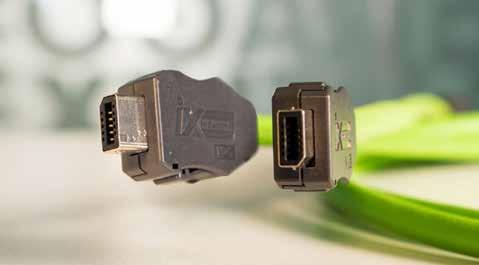
Compared to a classic RJ45 socket, a socket with the new mating face offers up to 70% space savings.
Helukabel
New products reflect an expansion of solutions for industrial communications.
With the ETHERLINE T1 product family, LAPP was ahead of the game in presenting prototype single-pair Ethernet cables for use in industrial machinery and systems.
As part of its spring launch, LAPP is introducing the new ETHERLINE T1 Y Flex 1x2x22/7 AWG. This is an UL-certified 2-core data cable for high-speed information exchange that maintains the same high data rates while significantly reducing the setup required. Thanks to its small bending radii and small outer diameter, it is exceptionally lightweight, space-saving and easy to install and is indispensable for connection at the field level.
The new Power-Over-Data-Line compatible cable complies with IEEE 802.3bu and was specially designed for transmitting digital signals in the frequency range up to 600 MHz over distances of up to 40 m. It enables a simultaneous power and data supply to SPE terminals with low energy consumption (up to 50 W).
The design of the SPE cable guarantees ideal protection against electromagnetic interference: Thanks to an aluminumlaminated foil and copper braid shield with a high degree of coverage (SF/UTP), it is double shielded. In addition, the PVC outer sheath is resistant to acids and alkalis and is partially oil-resistant. UL/CSA certification enables the product to be used in North America.
Another new feature is the ETHERLINE CABINET CAT.6A.for the control cabinet in PROFINET networks. Thanks to their small bending radii, Cat.6A patch cables can prove especially useful in confined spaces.
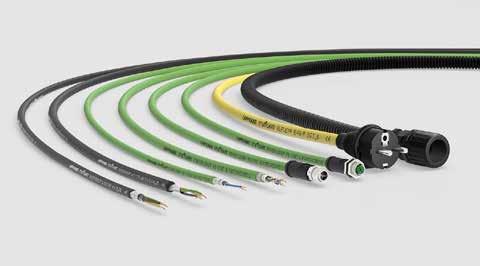
The LAPP portfolio already includes single-pair Ethernet cables. The company based the connector on the standardised connector face set out in IEC 63171-6, providing a complete solution for SPE infrastructure in industry.
Lapp
Visit Website
Hybrid connection solutions
HDC HMN shielded Cat 5e modules from TE Connectivity provide solution for robotics & automation systems.
TE Connectivity (TE) has launched HDC HMN shielded Cat 5e modules to expands their HMN range — modules that enable high-speed data transmission.
The HDC HMN system, designed for harsh industrial applications, offers various options for power, signal and data connections. The new addition makes TE’s HDC HMN system an option for robotics and automation applications.
New modules are available with two or six contacts in each circular insert, with up to three inserts in a single HMN module.
The HDC HMN modules offer: • High signal integrity through individual shielding of each Ethernet pair • Enhanced flexibility with high-density data inserts in standardized module, compatible with entire HMN range • Ease of assembly
“TE customers using HDC HMN modular connectors will benefit from these additional options to create, customized interfaces,” said Ewa Bazior, product manager at TE Connectivity. “The connectors also allow transmission of power, signal and high-speed data with an optimum amount space on the panel and a reduced number of cables needed.”
Possible applications include connections between control cabinets and a robot base, various connections between fixed and moving parts in automated assembly and production lines, and connections in electrical and pneumatic handling equipment.
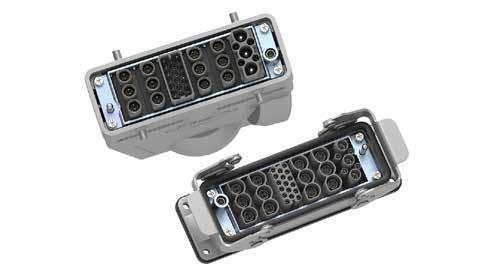
Hybrid connection solution from TE Connectivity offers versatility for industrial applications and robotics.
TE Connectivity
Y-Con Cover 20-TC for RJ45 Y-Con plugs with piercing contacts is available from Yamaichi.
The new Y-Con Cover 20-TC from Yamaichi replaces the current version of Y-Con Cover 20, which has a great acceptance in the market for many years. Like Y-Con Cover 20, the new Y-Con Cover 20-TC is an IP20 full metal version, which protects the plug from all kind of influences in an IP20 industrial area.
Strong mechanical resistance paired with a high protection against EMI disturbance guarantees the optimal signal transmission.
Moreover, the Y-Con Cover 20-TC can be assembled tool free. The new snap hook concept makes screws redundant so that the upper and lower part only need to be pressed together.
Characteristics
• Robust die cast housing • Completely metal-covered RJ45 interface • Tool-free click assembly • Reusable up to 5 times • Supporting outer cable dimensions from 5.5 mm up to 7.1 mm
This saves about 30% to 50% assembly time and thus means pure cost reduction. It does not even take into account the possibility of screws falling down or being lost. If necessary, the cover can be reassembled up to 5 times.
Together with our Y-Con Plug connector series, which is available with a different number of contacts, the Y-Con Cover 20-TC can be used for various RJ45 applications. The plug series is also constructed and tested for rough applications as are common in the industrial sector.
In addition, optional integrated power contacts offer the possibility for the power transmission of up to 2.1A.
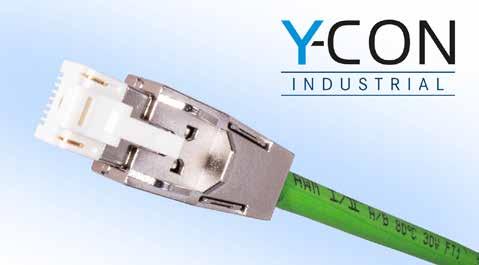
Snap hook concept makes screws redundant, so that the upper and lower part only needs to be pressed together.
Yamaichi
Visit Website
M12-Mini X-Code cable connectors
Provertha offers new 10GigE cable connectors for high-speed Ethernet with shock and vibration protection.
The performance of Provertha's M12-Mini X-Code cable connector series has been officially documented on the basis of certifications according to relevant standards. The certification covers all straight and angled (backplane) 10 Gbit Ethernet variants in the reliable, vibration-proof crimp connection technology. The turned crimp contacts have a significantly higher current carrying capacity for use in special applications.
The M12-Mini X-Code in protection class IP67 (screw-locked) is the industry's most compact 10GigE cable connector for spacesaving Ethernet or Profinet connection, which can be used in a temperature range from -40°C to +85°C.
All M12-Mini X-Code connectors have successfully passed the tests according to DIN EN 61373 (category 1, class B, and 2). In addition, they feature the 500h corrosion protection, proven by successfully passing the salt spray test according to EN 60512-11-6. Furthermore, the complete test programme according to the M12 connector standard IEC 61076-2-109 including the test group FP for the electrical transmission parameters was successfully passed in a certified test laboratory.
M12-Mini X-Code cable connectors are suited for railway applications, as well as for harsh industrial environments subject to shock and vibration such as automotive presses. Due to corrosion protection and increased shock and vibration resistance, the M12-Mini X-Code connectors are designed for mobile automation applications.
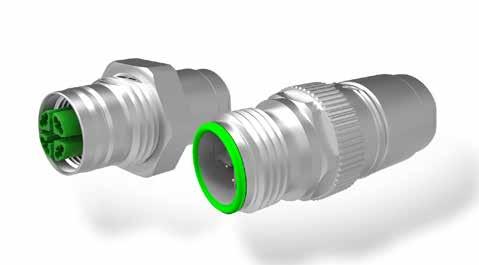
The M12-Mini X-Code is a compact 10GigE cable connector for space-saving Ethernet or Profinet connections.
Provertha
Hirose Electric has developed the C.FL Series as a 0.92mm mated height, ultra-small coaxial connector supporting 30GHz, designed for 5G millimeter wave devices and CPE (Customer Premises Equipment).
Millimeter wave bands are anticipated to be used for next generation standard 5G communications. Higher frequencies than ever before are expected to be transmitted in the internal connection between the antenna board and the main board of 5G devices and CPE. Demand for connectors that secure band performance is also increasing.
Hirose has developed the small coaxial connector C.FL Series which supports 30GHz in anticipation of greater millimeter wave band usage. In spite of the ultra-low profile and small size with 0.92mm mated height, the frequency characteristics have been dramatically enhanced by reducing the diameter of the male receptacle contact and optimizing the internal design of the plug.
In addition, the assembly's precision has been improved compared to conventional products, contributing to stable transmission in the millimeter wave band. Furthermore, the applicable cable size is a very thin and flexible, making it easy to route inside devices.
The newly developed C.FL Series meets the demanding performance requirements for millimeter wave devices. As part of the product lineup, we are developing cable assembly products with a 2.4mm connector or 2.92mm connector on the other side for evaluation and measurement of 5G devices. We anticipate these cable assemblies will be used in a variety of upcoming IoT devices supporting 5G.
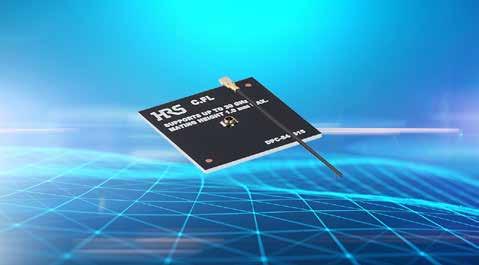
Higher frequencies than ever before are expected to be transmitted in the internal connections of 5G devices.
Hirose
Visit Website
Cat7 Industrial Ethernet cables
LUTZE offers teal jacket for stationary applications and green jacket for continuous motion applications.
LUTZE is offering two Cat7 industrial Ethernet cables; one for stationary applications (A1040300), and the other for continuous motion applications (104404).
Cat7 Ethernet cables support transfer speeds of 10Gbps and frequencies up to 600 Mhz. Cat7 is backwards compatible which means it can service prior Cat5e, Cat6, and Cat6A standards all while “future-proofing” any upcoming network expansions. Cat7 has the strictest specifications for signal integrity, including shielding between individual pairs as well as an overall braided shield. Cat7 Ethernet cables are designed to ensure network reliability in the harshest industrial environments.
Ethernet cable #A1040300 is intended for stationary applications and carries multiple approvals including CMR, CMX Outdoor, PLTC, and AWM 600V. These approvals allow this cable to be installed in a variety of applications. Designed with a rugged oil resistant teal PVC jacket, this cable is suitable for harsh industrial environments.
SUPERFLEX cable #104404 is intended for continuous motion installations and is rated up to 20 million flexing cycles. This cable is UL Listed Type CMX and is compatible with all major drag chain brands. The green PUR jacket is oil resistant, highly abrasion resistant and designed for harsh industrial environments.
With a wide a variety of cables, connectors and connectivity solutions, LUTZE is a complete solutions provider for industrial Ethernet applications. These cables complement LUTZE’s already broad Ethernet cable and connectivity product solutions.
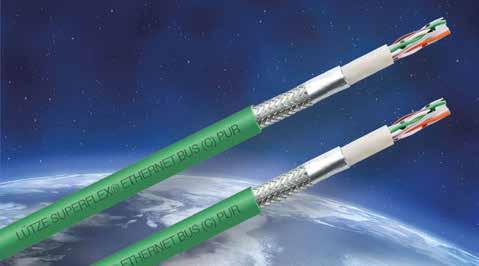
Cat7 Ethernet cables support transfer speeds of 10Gbps and frequencies up to 600 Mhz.

